A) sphere
B) cube
C) tetrahedron
D) line
E) plane.
Correct Answer

verified
Correct Answer
verified
Multiple Choice
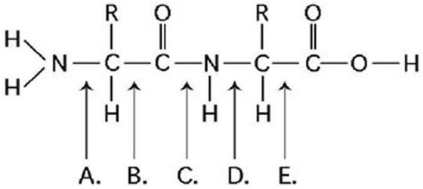 Figure 3.12
-At which bond in Figure 3.12 would water need to be added to achieve hydrolysis of the dipeptide resulting in production of its component amino acids?
Figure 3.12
-At which bond in Figure 3.12 would water need to be added to achieve hydrolysis of the dipeptide resulting in production of its component amino acids?
A) A
B) B
C) C
D) D
E) E
Correct Answer

verified
Correct Answer
verified
Multiple Choice
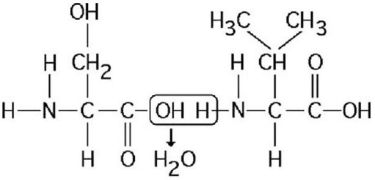 Figure 3.11
Which of the following statements regarding the chemical reaction illustrated in Figure 3.11 is true?
Figure 3.11
Which of the following statements regarding the chemical reaction illustrated in Figure 3.11 is true?
A) It is a hydrolysis reaction.
B) It results in a peptide bond.
C) It forms a disaccharide.
D) It forms two amino acids.
Correct Answer

verified
Correct Answer
verified
Multiple Choice
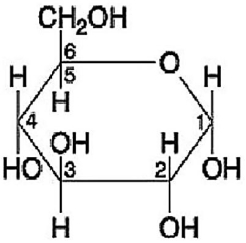 Figure 3.7
-If two of the molecules shown in Figure 3.7 are linked together,carbon-1 of one molecule to carbon-4 of the other,the bond that is formed would be found in which of the following polymers?
Figure 3.7
-If two of the molecules shown in Figure 3.7 are linked together,carbon-1 of one molecule to carbon-4 of the other,the bond that is formed would be found in which of the following polymers?
A) cellulose
B) glycogen
C) chitin
D) polypeptide
E) nucleic acid
Correct Answer

verified
Correct Answer
verified
Multiple Choice
Which of the following polymers lacks nitrogen?
A) protein
B) RNA
C) glycogen
D) chitin
Correct Answer

verified
Correct Answer
verified
Multiple Choice
If cells are grown in a medium containing radioactive 32P,which of these molecules will be radioactively labeled?
A) triacylglycerols
B) nucleic acids
C) fatty acids
D) starch
Correct Answer

verified
Correct Answer
verified
Multiple Choice
Which of the following will be most soluble in water?
A) organic hydrocarbons
B) organic hydrocarbons with hydroxyl groups attached
C) organic hydrocarbons with sulfhydryl groups attached
D) organic hydrocarbons with methyl groups attached
Correct Answer

verified
Correct Answer
verified
Multiple Choice
 Figure 3.9
-Which of the following statements regarding the molecule illustrated in Figure 3.9 is true?
Figure 3.9
-Which of the following statements regarding the molecule illustrated in Figure 3.9 is true?
A) It is a saturated fatty acid.
B) It is an entirely nonpolar molecule.
C) Molecules of this type are usually liquid at room temperature.
D) It is highly soluble in water.
Correct Answer

verified
Correct Answer
verified
Multiple Choice
Which of the following statements concerning unsaturated fats is true?
A) They are more common in animals than in plants.
B) They have double bonds in their fatty acid chains.
C) They generally solidify at room temperature.
D) They contain more hydrogen than do saturated fats having the same number of carbon atoms.
Correct Answer

verified
Correct Answer
verified
Multiple Choice
The molecular formula for glucose is C6H12O6.What would be the molecular formula for a polymer made by linking 10 glucose molecules together by dehydration reactions?
A) C60H120O60
B) C60H102O51
C) C60H100O50
D) C60H111O51
Correct Answer

verified
Correct Answer
verified
Multiple Choice
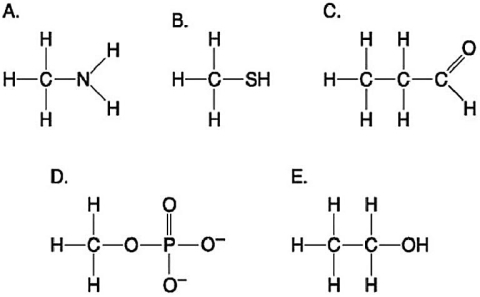 Figure 3.6
-Which molecule shown in Figure 3.6 can form a covalent bond between side chains (R groups) in a polypeptide?
Figure 3.6
-Which molecule shown in Figure 3.6 can form a covalent bond between side chains (R groups) in a polypeptide?
A) A
B) B
C) C
D) D
E) E
Correct Answer

verified
Correct Answer
verified
Multiple Choice
Bonds formed between the side chains (R groups) in a polypeptide are most important in stabilizing which of the following?
A) primary structure
B) secondary structure
C) tertiary structure
D) quaternary structure
Correct Answer

verified
Correct Answer
verified
Multiple Choice
Which of the following classes of biological molecules consist of both small molecule monomers and macromolecular polymers?
A) lipids
B) carbohydrates
C) proteins
D) nucleic acids
Correct Answer

verified
Correct Answer
verified
Multiple Choice
How many electron pairs does carbon share in order to complete its valence shell?
A) 1
B) 2
C) 3
D) 4
E) 8
Correct Answer

verified
Correct Answer
verified
Multiple Choice
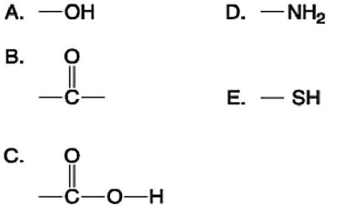 Figure 3.4
-Which of the groups in Figure 3.4 is a basic functional group that can accept H+ ions and become positively charged?
Figure 3.4
-Which of the groups in Figure 3.4 is a basic functional group that can accept H+ ions and become positively charged?
A) A
B) B
C) C
D) D
E) E
Correct Answer

verified
Correct Answer
verified
Multiple Choice
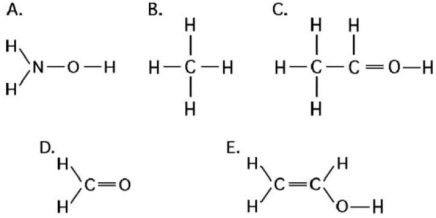 Figure 3.3
-Which of the structures illustrated in Figure 3.3 contain(s) only nonpolar single covalent bonds?
Figure 3.3
-Which of the structures illustrated in Figure 3.3 contain(s) only nonpolar single covalent bonds?
A) A only
B) B only
C) B and C
D) B and D
E) B and E
Correct Answer

verified
Correct Answer
verified
Multiple Choice
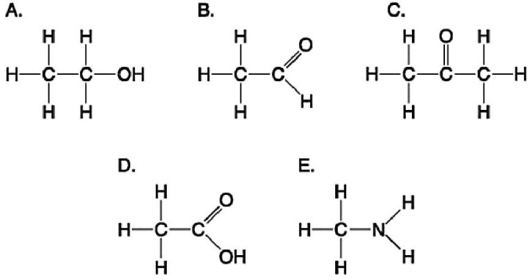 Figure 3.5
-Which molecule shown in Figure 3.5 contains a carboxyl group?
Figure 3.5
-Which molecule shown in Figure 3.5 contains a carboxyl group?
A) A
B) B
C) C
D) D
E) E
Correct Answer

verified
Correct Answer
verified
Multiple Choice
A nutritional supplement developed for athletes is shown to contain only carbon,hydrogen,and oxygen.Based on these data,you may safely conclude that
A) the food may contain carbohydrates and protein.
B) the food may contain carbohydrates and nucleic acids.
C) the food may contain lipids and protein.
D) the food may contain carbohydrates and lipids but not protein.
Correct Answer

verified
Correct Answer
verified
Multiple Choice
The α helix and β pleated sheet are examples of which level of protein structure?
A) primary
B) secondary
C) tertiary
D) quaternary
E) primary and tertiary
Correct Answer

verified
Correct Answer
verified
Multiple Choice
A carbon atom is most likely to form which of the following bonds with other atoms?
A) ionic bonds
B) hydrogen bonds
C) covalent bonds
D) covalent bonds and hydrogen bonds
Correct Answer

verified
Correct Answer
verified
Showing 101 - 120 of 136
Related Exams